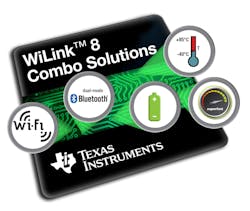Modules Ease Wi-Fi Integration for Industrial and IoT Applications
Texas Instruments has a long history in connectivity; even within the wireless realm. But providing wireless connectivity in a way that makes it easy for system developers was not something that TI previously had to worry much about. But in this Internet of Things (IoT) era, with all the “things” that can connect to the Internet, there are customers who want to get it done without having to be RF experts.
That’s why TI has now introduced combo connectivity modules for its WiLink 8 product, making it easier to add Wi-Fi and dual-mode Bluetooth to embedded applications. The modules integrate WiLink 8 capabilities with software and processors and are also pre-certified. They require less hardware and RF design experience than previous WiLink products.
Previously, TI customers had to build systems on their own to get the integration they needed for embedded applications, or go to a third party provider, said Mattias Lange, product line manager for WiLink 8. Now they can buy the highly integrated modules from TI.
“As a customer, I’m saving a lot of time. I can go straight to TI to buy the modules,” Lange says. “I can put these on the board without having to be an RF expert.”
When the need for Wi-Fi connectivity was less prevalent, it wasn’t such an issue for embedded developers to be RF experts, Lange pointed out. But times have changed, and there’s now more need for that expertise to come directly from TI. “People used to use them in PCs, then came smartphones and tablets,” he says. “Wi-Fi technology is exploding, and now a lot of people want to connect their things to the Internet.”
Ken Sooknanan, senior architect of the Connected Life Gateway program at Cisco, attests to the ease that the new modules provide. “As a fully integrated solution, using the WiLink 8 modules allowed for reduced development time and quicker time to market. Additionally, the cycle time to get necessary industry certifications and regulatory certification were greatly improved,” he says. “For IoT products, where multiple hardware variants are needed to address specific markets, the WiLink 8 module fit our needs very well.”
The new WiLink 8 modules are also now more useful for industrial applications because of an extended temperature range (-40 to 85 °C) and support for the 5 GHz band in addition to 2.4 GHz. Throughput is available up to 100 Mbps. Six different modules are available to provide flexibility and scalability, and all are pin-to-pin compatible, Lange noted.
There’s a lot of cutting-edge technology already offered with WiLink 8 that now is integrated into the modules, and customers now also get easy access to development tools, software and support for a variety of applications. “It’s still a high-performance device, but now available for people who are not normally used to these technologies,” Lange said. “If I need to add Wi-Fi, how do I do it, where do I start? It turns out it’s not trivial.”

